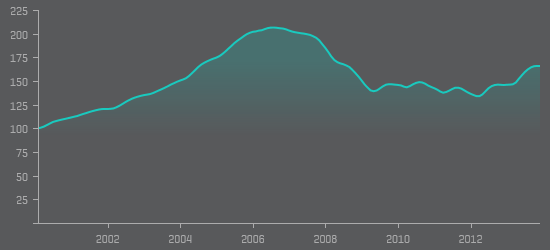Mortgage Bonds traded higher during Friday’s session, but the gains were modest as Stock prices traded much higher for most of the session. But towards 4pm ET, Stocks turned negative. There were no economic reports released. The 4% coupon rose by 12bp to end the session at 103.81. The Dow lost 23.40 points to 16,307.39, the S&P fell by 5.38 points to 1,866.59, while the Nasdaq dropped by 42,49 points to 4,276.78. We will continue to recommend floating, not locking into Mortgage Rates as Mortgage Bonds seem to be stabilizing.
Weekly Survey of Rates from the Mortgage Bankers Association
The average contract interest rate for 30-year fixed-rate mortgages with conforming loan balances ($417,000 or less) decreased to 4.50 percent from 4.52 percent, with points decreasing to 0.26 from 0.29 (including the origination fee) for 80 percent loan-to-value ratio (LTV) loans.
The average contract interest rate for 30-year fixed-rate mortgages with jumbo loan balances (greater than $417,000) decreased to 4.39 percent from 4.41 percent, with points decreasing to 0.19 from 0.20 (including the origination fee) for 80 percent LTV loans.
The average contract interest rate for 15-year fixed-rate mortgages decreased to 3.52 percent from 3.53 percent, with points decreasing to 0.25 from 0.28 (including the origination fee) for 80 percent LTV loans.
Commercial Real Estate Lending
Commercial Mortgage backed Securities (CMBS)– The 10 Yr Swap rate moved lower to finish the week at 2.83%, down from last weeks 2.71%.
Fed tapers another $10 billion
At its first meeting under new Chair Janet Yellen, the Federal Reserve agreed to dial down its stimulus package another notch, and changed its view on when interest rates will rise. In moves widely anticipated by financial markets, the Fed Open Market Committee voted to reduce the pace of its monthly asset purchase program by $10 billion to $55 billion—a continuing process in the market known as “tapering.” Read more
Housing News
U.S. Home Resales drop 0.4% to 19-month Low
U.S. home resales dropped slightly in February to a 19 month-low as cold weather and a shortage of homes for sale continued to sideline potential buyers. A separate survey showed factory activity in the U.S. mid-Atlantic region expanded far more than expected in March.
The National Association of Realtors said on Thursday home sales dropped 0.4 percent to an annual rate of 4.60 million units, the lowest level since July 2012, and in line with economists’ expectations. January’s sales pace was unrevised at 4.62 million. Read more
Home builders still cold on spring market
Confidence among the nation’s home builders edged up slightly in March but is still mired in the negative, way down from recent highs. After plummeting 10 points in February, a monthly sentiment index from the National Association of Home Builders (HMI) rose just 1 point to 47. The line between positive and negative sentiment is 50 on the survey.
“The March HMI mirrors last month’s sentiment, as builders continued to be affected by poor weather and difficulties in finding lots and labor,” said NAHB Chairman Kevin Kelly, a home builder from Wilmington, Del. Read more
Housing starts slide for 3rd straight month; price pressure dormant
U.S. housing starts fell for a third straight month in February, but a rebound in building permits offered some hope for the housing market as it struggles to emerge from a soft patch. The Commerce Department said on Tuesday groundbreaking slipped 0.2 percent to a seasonally adjusted annual rate of 907,000 units. That followed January’s revised 11.2 percent decline and suggested underlying weakness in housing activity apart from the drag of cold weather. January starts were previously reported to have tumbled 16 percent.
Economists polled by Reuters had expected starts to rise to a 910,000-unit rate last month. Read more
Economic News
U.S. Weekly Jobless claims tick higher; four week average hits 4- month low
The number of Americans filing new claims for unemployment benefits rose less than expected last week, pointing to some underlying strength in the labor market.
Initial claims for state unemployment benefits increased 5,000 to a seasonally adjusted 320,000, the Labor Department said on Thursday. Claims for the week ended March 8 were unrevised. Economists polled by Reuters had forecast first-time applications for jobless benefits rising to 325,000 in the week ended March 15.
The four-week moving average for new claims, considered a better measure of underlying labor market conditions as it irons out week-to-week volatility, fell 3,500 to 327,000, the lowest level since November. Read more
U.S. industrial production rose 0.6 percent in February. Economists polled by Reuters had expected industrial production to rise 0.2 percent. A separate report released earlier Monday showed factory activity in the New York state region accelerated in March.
Inflation tame at the consumer level – Consumer Price Index at 0.1% vs the 0.2% expected in February. Core at 0.1%, inline. U.S. consumer prices rose marginally in February, but the lack of inflation pressures will probably not dissuade the Federal Reserve from dialing back its monetary stimulus.
The Labor Department said its Consumer Price Index nudged up 0.1 percent as a decline in gasoline prices offset an increase in the cost of food. The CPI had ticked up 0.1 percent in January and last month’s gain was in line with economists’ expectations. Read more
Sources: CNBC, Bloomberg, MMG, Housingwire, Reuters














